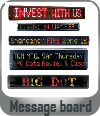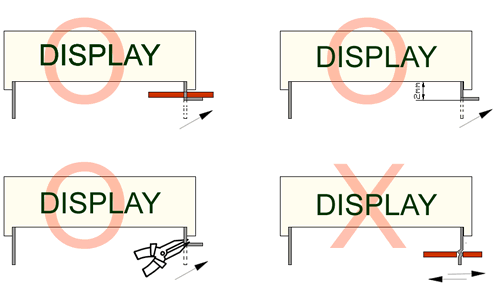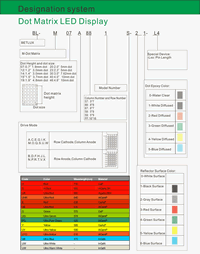1.2 inch height 5×7 LED dot matrix
Series No:
Weight:(g/pcs)
Dimension:(mm)
Dot height:(mm)
Dot pitch:(mm)
Dot size:(mm)
Specification:
Inquiry
Description:
Introduction
The 1.2 inch height 5×7 LED dot matrix has become a cornerstone in the world of advanced display technology, noted for its versatility and clarity. This 5×7 matrix—often referred to as a “large LED matrix” due to its relatively sizable dimensions—integrates seamlessly into various applications, from industrial to consumer electronics, offering exceptional visibility and performance. This article explores its key features, diverse applications, notable benefits, and includes firsthand case studies and testimonials from industry professionals.
Key Features of the 1.2 Inch 5×7 LED Dot Matrix
The 1.2 inch 5×7 LED dot matrix stands out with its:
- High Visibility: The increased height enhances display readability from greater distances, making it ideal for public information systems and outdoor applications.
- Versatile Color Options: While often found in a “blue display” variant, it supports multiple color configurations, adding to its utility across different uses.
- Robust Design: Built to last, this LED matrix is durable and suited for both indoor and outdoor environments, resisting various weather conditions and mechanical impacts.
Applications Across Diverse Sectors
This versatile LED matrix finds use in numerous fields:
- Advertising Displays: Large billboards and dynamic signs that require high visibility and color flexibility use this matrix to captivate audiences.
- Transportation: Utilized in train stations, airports, and bus stops for real-time scheduling and alerts.
- Consumer Devices: Home appliances and personal gadgets often feature this matrix for user interface displays, providing clear and immediate feedback to users.
Benefits of Using the 1.2 Inch 5×7 LED Dot Matrix
- Enhanced User Experience: The clarity and size of the display improve user interaction with devices, particularly in environments where quick information absorption is crucial.
- Energy Efficiency: Despite its larger size, the LED technology ensures that the matrix remains energy efficient, helping reduce electricity costs and environmental impact.
- Ease of Integration: Compatible with numerous electronic devices and systems, the matrix can be easily integrated into new and existing projects without extensive modifications.
Case Studies: Real-World Applications
Detailed case studies from the fields of public transportation, advertising, and consumer electronics illustrate how the 1.2 inch 5×7 LED dot matrix has been successfully implemented, highlighting its adaptability and effectiveness.
User Testimonials
Insights from electronics engineers reveal how the 5×7 matrix has revolutionized their product designs, enhancing both the functionality and aesthetic appeal of their projects.
Conclusion
The 1.2 inch height 5×7 LED dot matrix offers a blend of performance, durability, and versatility, making it a preferred choice for manufacturers and designers across various industries. Its ability to convey information effectively, paired with its robust build, ensures it remains a leading choice for both current and future display needs.
Call to Action Elevate your electronic displays with the robust and versatile 1.2 inch 5×7 LED dot matrix. Contact us today to see how this innovative technology can enhance your projects and applications.

Features
- Matrix Dimensions: This matrix has a height of 30.42mm, with a display width and height of 22.75×31.80mm. Its compact size is efficient for many display requirements.
- Dot Size and Shape: The dot size is 3.00mm, circular in shape, offering clear and distinct points of light for readability and display quality.
- Column and Row Configuration: The matrix features 5 columns and 7 rows, providing a grid that supports a variety of simple display patterns.
- Low Power Operation: Designed for low current usage, it is energy-efficient, suitable for long-term operation without substantial power consumption.
- High Contrast and Brightness: The matrix ensures high contrast and light output, which makes the display easily readable in various lighting conditions.
- Code Compatibility: Compatible with ASCII and EBCDIC codes, the matrix is versatile for a range of programming and display purposes.
- Horizontal Stackability: It can be stacked horizontally, which is beneficial for creating larger or more complex display setups.
- Flexible Circuit Design Options: Available with both column cathode and anode options, providing flexibility for different electronic circuit designs.
- Ease of Mounting: The matrix is designed for easy installation on printed circuit boards or sockets, simplifying its integration into various projects.
- Luminous Intensity Consistency: LEDs are categorized for luminous intensity, ensuring uniform brightness across the display.
- Durability: Technically rugged, enhancing its reliability for various applications and operational environments.
- Aesthetic Design: Features a standard gray surface with white dots, offering a professional appearance.
- Environmental Compliance: RoHS compliance indicates that the matrix is manufactured with environmentally friendly practices.
Applications
- Compact Electronic Displays: Ideal for applications where space is limited but a clear display is needed, such as small electronic devices or wearable technology.
- Customized Indicators: Suitable for creating custom indicators or readouts in machinery, appliances, or other electronic equipment.
- Educational Tools: Can be used in educational settings for teaching basic electronics and programming, or for creating simple interactive displays.
- Interactive Art Projects: Appropriate for small-scale interactive art installations or design projects.
- DIY Electronics: An excellent choice for hobbyists and DIY enthusiasts for building custom gadgets, lighting solutions, or experimental projects.
- Informational Signage: Suitable for small-scale informational displays in public areas, offices, or retail environments.
- Prototyping: Useful for prototyping smaller electronic components or systems where display information is necessary.


Electrical-optical characteristics:
Part No.(Row Cathode) | Part No. (Row Anode) | Color | Material | Peak Wavelength (nm) | Voltage typ. (v) | Voltage Max. (v) | Luminous Min. | Luminous typ. |
|---|---|---|---|---|---|---|---|---|
BL-M12A572B |
BL-M12B572B |
ultra Blue |
InGaN/SiC |
470 |
4.2 |
20 |
50 |
|
BL-M12A572D |
BL-M12B572D |
Super Red |
GaAlAs/DH |
660 |
2.2 |
70 |
110 |
|
BL-M12A572E |
BL-M12B572E |
Orange |
GaAsP/GaP |
635 |
2.5 |
50 |
90 |
|
BL-M12A572G |
BL-M12B572G |
Green |
GaP/GaP |
570 |
2.5 |
55 |
95 |
|
BL-M12A572PG |
BL-M12B572PG |
Ultra Pure Green |
InGaN/SiC |
525 |
4.2 |
110 |
150 |
|
BL-M12A572S |
BL-M12B572S |
Hi Red |
GaAlAs/SH |
660 |
2.2 |
60 |
100 |
|
BL-M12A572UB |
BL-M12B572UB |
ultra Blue |
InGaN/SiC |
470 |
4.2 |
30 |
70 |
|
BL-M12A572UE |
BL-M12B572UE |
Ultra Orange |
AlGaInP |
630 |
2.5 |
60 |
100 |
|
BL-M12A572UG |
BL-M12B572UG |
Ultra Green |
AlGaInP |
574 |
2.5 |
100 |
130 |
|
BL-M12A572UR |
BL-M12B572UR |
Ultra Red |
GaAlAs/DDH |
660 |
2.2 |
90 |
120 |
|
BL-M12A572UY |
BL-M12B572UY |
Ultra Yellow |
AlGaInP |
590 |
2.5 |
60 |
100 |
|
BL-M12A572W |
BL-M12B572W |
Ultra White |
InGaN |
- |
4.2 |
100 |
||
BL-M12A572Y |
BL-M12B572Y |
Yellow |
GaAsP/GaP |
585 |
2.5 |
50 |
90 |
Package configuration & Internal circuit diagram
Partno description:
More Information
Reflector Surface color (1st number)/ dot Lens color (2nd number):
| Number | 0 | 1 | 2 | 3 | 4 | 5 |
| Ref Surface Color | White | Black | Gray | Red | Green | |
| Dot Epoxy Color | Water clear | White diffused | Red Diffused | Green Diffused | Yellow Diffused |
Absolute maximum ratings (Ta= 25°C)
| Parameter | S | D | UR | E | Y | G | Unit | |
| Forward Current IF | 25 | 25 | 25 | 25 | 25 | 30 | mA | |
| Power Dissipation Pd | 60 | 60 | 60 | 60 | 60 | 65 | mW | |
| Reverse Voltage VR | 5 | 5 | 5 | 5 | 5 | 5 | V | |
| Peak Forward Current IPF (Duty 1/10 @1KHZ) | 150 | 150 | 150 | 150 | 150 | 150 | mA | |
| Operation Temperature TOPR | -40 to +80 | °C | ||||||
| Storage Temperature TSTG | -40 to +85 | °C | ||||||
| Lead Soldering Temperature TSOL | Max.260+ 5°C for 3 sec Max. ( 1.6mm from the base of the epoxy bulb) | °C | ||||||
Absolute maximum ratings (Ta= 25°C)
| Parameter | UHR | UE | YO | UY | UG | PG | UB | UW | Unit |
| Forward Current IF | 30 | 30 | 30 | 30 | 30 | 30 | 30 | 30 | mA |
| Power Dissipation Pd | 75 | 65 | 65 | 65 | 75 | 110 | 120 | 120 | mW |
| Reverse Voltage VR | 5 | 5 | 5 | 5 | 5 | 5 | 5 | 5 | V |
| Peak Forward Current IPF (Duty 1/10 @1KHZ) | 150 | 150 | 150 | 150 | 150 | 150 | 100 | 100 | mA |
| Operation Temperature TOPR | -40 to +80 | °C | |||||||
| Storage Temperature TSTG | -40 to +85 | °C | |||||||
| Lead Soldering Temperature TSOL | Max.260+ 5°C for 3 sec Max. ( 1.6mm from the base of the epoxy bulb) | °C | |||||||
Related Information
Applied for:




1. Application
The Seven Segment LED is widely applied for ordinary electronic equipment (such as office equipment,
communication equipment and household applications). Checking with BETLUX’s Sales in
advance for information on applications in which exceptional reliability is required, particularly
when the failure or malfunction of the LEDs may directly jeopardize life or health (such as in
aviation, transportation, traffic control equipment, medical and life support systems and safety
devices).
2. Storage
The storage ambient for the Seven Segment LED should not exceed 30℃ temperature or 70% relative humidity.
For extended storage out of their original packaging, it is recommended that the Seven Segment LEDs be stored
in a sealed container with appropriate desiccant, or in a desiccator with nitrogen ambient.
3. Cleaning
Avoid using any unspecified chemical solvent to clean LED . For example, Trichloroethylene, Chlorosen, Acetone, and Diflon S3MC.
Any cleaning method can only be taken under normal temperature in one minute or less if it is required.
Use water to clean the Seven Segment LED if necessary under room temperature
dry it immediately after that.
4.Forming
Any unsuitable stress applied to the epoxy may break bonding wires in LED
Any forming on lead pin must be done before soldering, not during or after soldering.
Avoid applying any stress to resin in order to prevent the epoxy fracture and break on bonding wire.
While forming, please use a tie bar cut or equivalent to hold or bend the pin.
2mm from the base of resin is the minimum distance for the place bending the lead pin.
Avoid bending the lead pin at the same point twice or more.

Soldering
When soldering, leave a minimum of 2mm clearance from the base of the base of the lens to the soldering point. Dipping the lens into the solder must be avoided.
Do not apply any external stress to the lead frame during soldering while the LED is at high temperature.
Recommended soldering conditions:
| IR Reflow Soldering (for SMD display) | Wave Soldering | Soldering Iron | |||
| Pre-Heat | 150-180°C | Pre-Heat | 100°C Max. | Temperature | 300°C Max. |
| Pre-Heat Time | 120sec Max. | Pre-Heat Time | 60sec Max. | ||
| Peak Temperature | 260°C Max. | SolderWave | 260°C Max. | Soldering Time | 3sec Max.(one time only) |
| Soldering Time | 10 sec Max. | Soldering Time | 5sec Max. | ||
Note: Excessive soldering temperature and/or time might result in deformation of the LED lens or failure of the LED
ESD(Electrostatic Discharge)
Static Electricity or power surge will damage the LED.
Suggestions to prevent ESD (Electrostatic Discharge):
n Use a conductive wrist band or anti-electrostatic glove when handling these LEDs
n All devices, equipment, and machinery must be properly grounded
n Work tables, storage racks, etc. should be properly grounded
n Use ion blower to neutralize the static charge which might have built up on surface of the LED’s
plastic lens as a result of friction between LEDs during storage and handling
ESD-damaged LEDs will exhibit abnormal characteristics such as high reverse leakage current,
low forward voltage, or “no light on” at low currents. To verify for ESD damage, check for “light on”
and Vf of the suspect LEDs at low currents.
The Vf of “good” LEDs should be>2.0V@0.1mA for InGaN product and >1.4V@0.1mA for AlInGaP
product.

LED dirve IC by Maxim Integrated
MAX6959 4½-Digit LED Display Driver
MAX6958 4½-Digit LED Display Driver
MAX6955 7-, 14-, 16-Segment LED Display Driver
MAX6956 LED Static Display Driver and I/O Port
MAX6954 7-, 14-, 16-Segment LED Display Driver
MAX6952 5 x 7 Matrix LED Display Driver
MAX6957 LED Static Display Driver and I/O Port
MAX6950 5-Digit LED Display Driver
MAX6951 8-Digit LED Display Driver
ICM7212 4-Digit LED Driver
ICM7212A 4-Digit LED Driver
ICM7212AM 4-Digit LED Driver
ICM7212M 4-Digit LED Driver
ICM7218A 8-Digit LED Driver
ICM7218B 8-Digit LED Driver
ICM7218C 8-Digit LED Driver
ICM7218D 8-Digit LED Driver
MAX7221 8-Digit LED Display Driver
MAX7219 8-Digit LED Display Driver
When selecting power for LED systems, it’s essential to understand several key parameters to ensure safe operation, longevity, and optimal performance. Here are some steps and considerations for LED power selection:
- Determine the Forward Voltage (Vf) of the LED(s):
Each LED has a forward voltage, which is the voltage at which the LED operates when the current is flowing through it. This value can typically be found in the LED’s datasheet.
- Determine the Forward Current (If) of the LED(s):
The forward current is the current at which the LED is designed to operate. Running an LED at higher than its rated current can reduce its lifespan and increase the heat it produces.
- Decide on the Configuration:
Series Configuration: When LEDs are connected in series, the forward voltages add up, but the current remains the same.
Parallel Configuration: When LEDs are connected in parallel, the forward voltage remains the same, but the currents add up. This configuration can be risky because if one LED fails or has a slightly lower forward voltage, it can cause the other LEDs to draw more current.
Calculate Total Power Requirements:
Power (W) = Total Forward Voltage (V) x Total Forward Current (A)
For example, if you have three LEDs connected in series, each with a forward voltage of 3V and a forward current of 20mA, the total power requirement would be:
Power = (3V + 3V + 3V) x 20mA = 9V x 0.02A = 0.18W
- Select an Appropriate Power Supply:
- Voltage Rating: The power supply voltage should match or slightly exceed the total forward voltage of your LED configuration.
- Current Rating: The power supply’s current rating should meet or exceed the total forward current of your LED configuration.
- Safety Margin: It’s a good practice to select a power supply that can provide at least 20% more power than your calculated requirement. This ensures the power supply isn’t operating at its maximum capacity, which can extend its life and ensure safer operation.
- Consider Additional Features:
- Dimming Capability: If you want to control the brightness of your LEDs, choose a power supply with dimming capabilities.
- Overcurrent and Overvoltage Protection: To protect your LEDs, select a power supply with built-in protection mechanisms.
- Thermal Management: Ensure that the power supply has adequate cooling, especially if it will be enclosed or in a location with limited airflow.
- Regulation and Efficiency:A power supply with good regulation will maintain a consistent voltage output despite variations in the load. High efficiency ensures minimal power is wasted as heat.
- Physical Size and Form Factor:Depending on where you plan to place the power supply, its size and shape may be critical factors.
In summary, when selecting power for LED systems, understanding your LED’s requirements and the configuration you plan to use is essential. Then, pick a power supply that meets those needs with some added safety margin, keeping in mind any additional features or constraints relevant to your project.
Here are some well-regarded brands in the industry:
- Mean Well: One of the most recognized brands in the LED power supply industry, Mean Well offers a wide range of products suitable for both indoor and outdoor applications. Their units often come with features like overcurrent protection, dimming capabilities, and high efficiency.
- Tridonic: A global leader in lighting technology, Tridonic offers LED drivers and power supplies that cater to various lighting solutions, from simple setups to advanced smart lighting systems.
- Philips Advance Xitanium: Philips is a well-known brand in the lighting industry, and their Xitanium series of LED drivers are known for reliability and performance. They cater to both indoor and outdoor LED applications.
- Osram: Another giant in the lighting industry, Osram offers a range of LED drivers and power supplies suitable for various applications, including architectural and street lighting.
- LIFUD: Specializing in LED drivers, LIFUD is known for its high-quality products that cater to both commercial and residential LED lighting solutions.
- MOSO: This brand offers a variety of LED drivers, especially for outdoor and industrial applications. Their products are known for durability and performance.
- TDK-Lambda: With a history in power electronics, TDK-Lambda offers a range of power supplies and LED drivers suitable for various applications, emphasizing reliability and advanced features.






